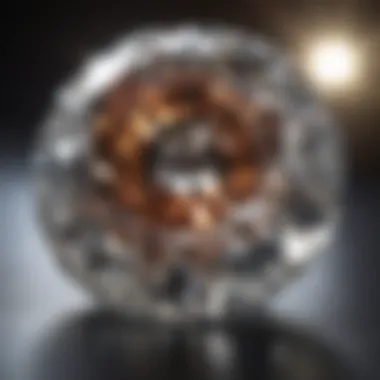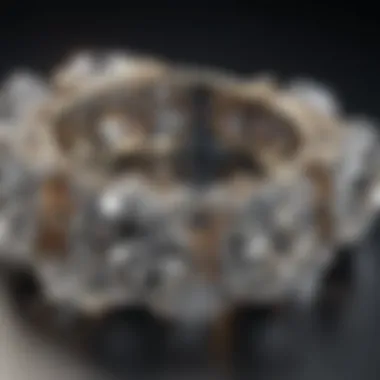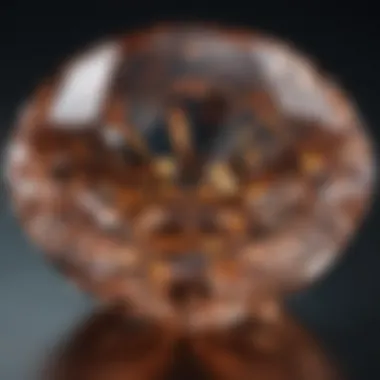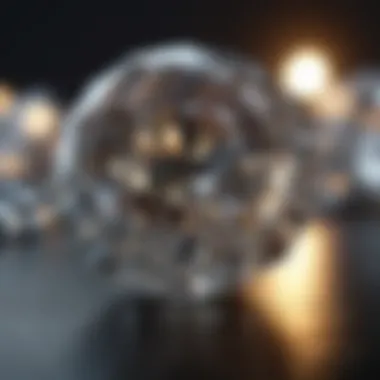Understanding the Cost of a Six Carat Diamond Ring


Intro
The intricacies of purchasing a six-carat diamond ring can be overwhelming for buyers, especially with the vast amount of information available. Understanding the various factors that contribute to the cost is not just valuable but essential for making informed choices. This article delves into the significance of the Four Cs—cut, color, clarity, and carat weight—as they play a crucial role in determining the value of a diamond. Furthermore, we will explore market trends, ethical considerations, and provide practical tips for prospective buyers. In doing so, we aim to equip readers with a comprehensive understanding of the financial implications associated with acquiring a high-value diamond ring while taking into account quality and personal preference.
Gemstone Overview
Definition of Gemstones
Gemstones are naturally occurring minerals that are cut, polished, and used in jewelry and other decorative items. They can be classified based on various factors like their chemical composition, formation process, and appearance. Diamonds, particularly, are valued for their hardness, brilliance, and rarity, making them one of the most sought-after gemstones in the world.
Classification of Gemstones
Gemstones can be broadly categorized into two main types: precious and semi-precious. Precious gemstones include diamonds, rubies, sapphires, and emeralds. These stones usually hold higher market value due to their rarity and beauty. Semi-precious gemstones encompass a wider variety of stones, such as amethyst, garnet, and citrine, though they are not less valuable in their own right.
Important insight: The classification of a gemstone not only affects its market value but also guides buyer preferences according to their individual tastes.
Understanding the basics of gemstones allows buyers to appreciate the factors influencing the pricing of a six-carat diamond ring. As we further explore this topic, several elements of significance shall be examined.
Prelude to Diamond Valuation
In the world of gemstone jewelry, understanding diamond valuation is crucial. This article will guide readers through the complexities involved in evaluating a six-carat diamond ring. Knowing the significance of various factors will inform better purchasing decisions. Buyers must understand what makes a diamond valuable beyond its size. The Four Cs—cut, color, clarity, and carat weight—are central to this discussion. Each factor contributes uniquely to a stone’s overall worth.
The diamond market also introduces variables that influence prices. Recognizing trends and market dynamics is essential for informed investments. Additionally, an understanding of ethical considerations in diamond sourcing is increasingly relevant. As consumers become more aware of their choices, this impacts purchasing behavior and market demand.
Ultimately, diamond valuation is not merely a technical affair. It encompasses emotions, cultural nuances, and personal significance. Investing in a diamond ring, especially one as substantial as six carats, moves beyond the transactional. Therefore, being educated about valuation equips buyers to appreciate the true worth of their investment and the stories behind these exquisite gems.
The Significance of Carat Weight
Carat weight is often seen as the primary indicator of a diamond's size. Each carat is equivalent to 200 milligrams, and a six-carat diamond is notably larger than average. However, it is essential to recognize that carat weight alone does not determine value. The perception of size can vary based on cut and stone proportions.
Larger diamonds are rarer and, consequently, command higher prices. However, the relationship between carat weight and price is not linear. For instance, a six-carat diamond can be exponentially more expensive than a five-carat one, primarily due to its rarity. Buyers should weigh the visual impact against ancillary costs.
When discussing carat weight, there is a tendency to overlook other characteristics affecting overall appeal. Cut quality and shape can make a diamond look larger or smaller compared to its carat weight. Thus, while carat weight is significant, it should be considered in conjunction with other attributes to understand the full picture of value.
An Overview of the Diamond Market
Understanding the diamond market is critical for anyone considering a six-carat diamond ring. The market is influenced by various elements such as supply, demand, and global economic conditions. Major players in the diamond industry include De Beers and Alrosa. They control significant portions of the rough diamond supply.
Prices can fluctuate based on consumer demand and economic factors. For example, during economic downturns, luxury purchases often decline. Research indicates that diamonds maintain value but may not consistently appreciate.
Additionally, market segmentation is relevant. Different demographics prioritize certain features, influencing what is in demand. Younger buyers may prefer ethically sourced diamonds or unique cuts and settings, while traditional segments might prioritize larger stones regardless of origin. Analyzing market trends provides insight into where investment value might lie.
"Understanding the dynamics of the diamond market is essential for informed purchases. The market's fluctuations can provide buyers an edge if they are knowledgeable about current trends."
The Four Cs of Diamonds
The Four Cs—Cut, Color, Clarity, and Carat Weight—form the fundamental principles of diamond valuation. Understanding these criteria is essential for anyone looking to purchase a six carat diamond ring. Each of these factors plays a significant role in determining the overall quality and value of the diamond. Therefore, it is imperative to examine each category carefully to navigate the complex diamond market effectively.
Cut: The Most Critical Factor
The cut of a diamond refers to how well it has been shaped and faceted. It directly affects the sparkle and brilliance of the gem. A well-cut diamond reflects light optimally, enhancing its beauty and market value. Buyers should prioritize cut quality when evaluating diamonds.
Factors influencing cut quality include geometry, proportions, and symmetry. Ideal cuts maximize light reflection, providing a dazzling appearance. Poor cuts, on the other hand, can result in dimness and diminish value. Thus, understanding cut grades—ranging from Excellent to Poor—is crucial for informed decisions.
Color: Subtle Shades and Their Impact


Color grading in diamonds ranges from colorless to light yellow or brown. The most sought-after diamonds are colorless, as these possess more brilliance and fire. The Gemological Institute of America (GIA) grades diamonds on a scale from D (colorless) to Z (light yellow).
The subtle differences in shade can significantly impact the value. For example, a D-grade diamond often costs considerably more than an H-grade diamond, yet the difference may be barely noticeable to the untrained eye. Understanding these grades helps buyers choose a diamond that meets their aesthetic and budgetary preferences.
Clarity: Understanding Imperfections
Clarity evaluates the presence of internal or external flaws—known as inclusions and blemishes. High clarity means fewer visible imperfections, which adds to the diamond's value. Clarity is graded on a scale from Flawless (no inclusions visible under 10x magnification) to Included, where inclusions are visible to the naked eye.
Many buyers may overlook clarity, but it is important to consider how inclusions might affect light performance. Minor inclusions may not detract significantly from the appearance but can impact resale value. Being aware of clarity ratings allows buyers to make well-informed purchases based on their priorities, whether beauty or investment.
Carat Weight: Beyond Numbers
Carat weight measures the size of the diamond, with one carat equivalent to 0.2 grams. While larger diamonds are generally more expensive, the increase in value is not linear. A six carat diamond can be exponentially more valuable than a smaller gem mostly due to rarity.
However, carat weight alone does not determine value. Cut, color, and clarity play intertwined roles. A six carat diamond may be less valuable if it has poor cut and color grades compared to a smaller diamond that excels in these categories. Therefore, buyers should consider the overall combination of the Four Cs rather than focusing solely on size.
Price Variations in Six Carat Diamonds
Understanding price variations in six-carat diamonds is crucial for any buyer. These fluctuations can significantly affect the overall cost and perceived value of a diamond ring. The price of a diamond is not a straightforward matter; many factors come into play that influence how much a buyer ultimately pays.
Different market conditions, the unique characteristics of each diamond, and even regional differences can create a broad range of prices. Recognizing these variables helps buyers make informed decisions and avoid overspending on their purchase.
Factors Influencing Price Fluctuations
Several elements contribute to the changes in price for a six-carat diamond. Here are key factors:
- Market Demand: The demand for diamonds can fluctuate based on economic conditions, trends in luxury spending, and even cultural influences. Higher demand typically leads to higher prices.
- Quality of the Four Cs: The cut, color, clarity, and carat weight affect a diamond's price prominently. A well-cut diamond with fewer imperfections and a vivid color will command a higher price.
- Certification: Diamonds certified by reputable organizations like the Gemological Institute of America (GIA) tend to be valued higher than those without certification. Buyers often pay a premium for assurance of quality.
- Branding and Retailer Markup: Different jewelers may price their diamonds differently based on branding, reputation, and overhead costs. This variability can affect buyers differently across different retailers.
Comparative Pricing: Market Analysis
Analyzing how six-carat diamonds are priced in the current market requires looking at various sources and comparing their offers.
- Price Ranges: Generally, six-carat diamonds can vary significantly in price, ranging from tens of thousands to hundreds of thousands of dollars. The specific qualities of the diamond, including its Four Cs, will often determine where within this range a particular diamond falls.
- Market Trends: Keeping an eye on current market trends can provide insights into whether prices are likely to rise or fall. Economic indicators, such as disposable income levels and trends in the luxury goods market, play vital roles in these movements.
"Understanding the market environment is essential. Knowledge is power when navigating the complexities of diamond purchasing."
Investing time to understand the comparative pricing of diamonds will yield financial benefits in the long run. Awareness of these dynamics ensures that a buyer can make a choice that meets both their aesthetic and financial expectations.
The Role of Certification in Diamond Buying
When purchasing a diamond, the concept of certification holds considerable weight in ensuring that buyers make informed decisions. It serves multiple significant roles, such as providing verification of quality and establishing trust in the diamond market. For a six-carat diamond ring, the implications of certification become even more crucial, as these gems represent a significant financial investment.
Certification not only offers insights into the diamond’s attributes but also protects the interests of buyers. In a market rife with variations in quality and authenticity, having a certified diamond can prevent potential misunderstandings or disputes. In essence, certification can be seen as a safeguard.
Understanding Gemological Certifications
Gemological certifications are assessments conducted by professional laboratories that evaluate a diamond’s characteristics. Notable organizations, such as the Gemological Institute of America (GIA) or the American Gem Society (AGS), conduct these evaluations. They grade diamonds based on the Four Cs: cut, color, clarity, and carat weight. Importantly, the grading carries a reputation, so a GIA certificate often holds more weight than an unrecognized certificate.
Buyers should look for important elements on a certification report:
- Clarity grade: Indicates the internal and external imperfections.
- Color grade: Describes the diamond’s hue, ranging from colorless to light yellow.
- Cut quality: Reflects how well the diamond has been shaped.
- Carat weight: Shows the size of the diamond.
Understanding these elements allows buyers to gauge what they are purchasing, ensuring they are aware of the investment they are making.
How Certification Affects Value


The existence of certification plays a critical role in influencing the value of a diamond. A gem with a reputable certification generally commands a higher price because of the assurance of quality it provides. If a buyer knows they are purchasing a certified diamond, they can feel more confident in its stated attributes.
Additionally, buyers can make comparisons easier. Since two diamonds with the same carat weight might differ in color or clarity, having a certification clarifies these differences, making it simpler to justify variations in pricing.
Furthermore, in cases where resale is a possibility, a certified diamond often holds up better in the market. Buyers can attract potential purchasers more efficiently by showcasing a certification from a recognized laboratory. This aspect amplifies the investment argument surrounding diamonds, particularly larger ones, like a six-carat gem.
"A certification is not just a document; rather, it is a promise of authenticity and quality that is essential in the diamond buying process."
Trends in Buying Diamond Jewelry
Understanding trends in buying diamond jewelry is essential for consumers navigating a complicated market. Buyers today have access to a wealth of information and choices. Recognizing the latest trends can enhance their buying experience and lead to more informed decisions. The landscape of diamond jewelry is evolving, driven by shifts in consumer preferences, technological advancements, and ethical considerations.
Analyzing current trends equips potential buyers with knowledge about designs that are gaining popularity, as well as insights into materials and sourcing practices. Shifts toward personal expression in jewelry choices also reflect broader cultural changes. Consumers now prioritize individuality and craftsmanship alongside traditional markers of quality. Here's a closer look at two key areas of focus within this evolving market.
Current Trends in Luxury Jewelry
The luxury jewelry sector is experiencing significant transformations. One prominent trend is the focus on bespoke and personalized pieces. Customers now seek unique creations that resonate on a personal level. Artisans and designers are responding by offering customizable options, allowing clients to select specific stones and settings that capture their story.
Another observable trend is the influence of minimalism. Simple and elegant designs are rising in demand as consumers often lean towards timeless pieces over extravagant ones. This shift often results in lower carat weights being favored, which can make high-quality diamonds more accessible to a broader audience.
Moreover, social media plays a vital role in shaping these trends. Platforms like Instagram and Pinterest are showcasing new styles and encouraging consumers to discover luxury pieces they might not have otherwise considered. The visibility of luxury jewelry has increased, driving interest and leading to informed purchase options.
Sustainable and Ethical Diamonds
Sustainability in the diamond industry has become increasingly important to consumers. Many buyers seek guarantees that their chosen diamonds are mined and produced ethically. The demand for transparency has prompted brands to disclose their sourcing practices.
Various certifications, such as the Kimberley Process, aim to prevent conflict diamonds from entering the market. However, the effectiveness of such certifications is often questioned. Consumers may turn to lab-grown diamonds as an alternative, which offer a more sustainable option without the ethical uncertainties associated with mined stones. These lab-created stones are generally more affordable, appealing to budget-conscious buyers looking for environmental assurances.
In summary, staying informed about trends in buying diamond jewelry is crucial for educated purchasing. From personalization to sustainability, these trends reflect significant cultural shifts in consumer behavior. As the jewelry market continues to evolve, understanding these nuances will allow buyers to make choices aligned with their values and preferences.
Practical Tips for Potential Buyers
When considering the purchase of a six-carat diamond ring, it is essential to approach the buying process with diligence. The right preparation can save you time and money while ensuring that you are making an informed decision. Understanding practical tips in the context of diamond purchases assists buyers in navigating a complex market with confidence and clarity.
Choosing the Right Jeweler
The jeweler you select plays a pivotal role in your buying experience. A reputable jeweler provides not only quality diamonds but also valuable information. While shopping, consider the following preferences:
- Research: Look for jewelers known for their credibility and ethical practices. Checking reviews can help gauge their reputation.
- Experience: Choose a jeweler with substantial experience, especially in high-value diamonds. Their expertise may aid in providing clarity on distinctions among various diamonds.
- Transparency: A good jeweler should be willing to share details about the diamond's grading. Understanding the Four Cs will help you assess value accurately.
Engagement with someone knowledgeable can also ease your worry about authenticity. Many reputable stores offer certification through recognized gemological institutions. This ensures that what you are buying aligns with the advertised quality and price.
Understanding Return Policies
Before finalizing your purchase, become familiar with the return policies of the jeweler. The nature of jewelry transactions can sometimes lead to buyer's remorse; therefore, the flexibility of these policies is critical. Key considerations include:
- Time Frame: Know how long you have to return or exchange a diamond ring. Some jewelers offer extended periods, while others may be more limited.
- Conditions for Return: Assess if the jewelry must be in perfect condition for a refund. Many policies specify that items must be unworn and include original packaging.
- Restocking Fees: Some jewelers charge a fee for returns. Understanding this beforehand can aid in your decision-making process.
Being informed about return policies allows you to shop with peace of mind, knowing you have options if your purchase does not meet expectations.
Setting a Budget: Cost Considerations
Budgeting is an often-overlooked aspect of purchasing a diamond ring. Given the high financial stakes, a clear budget helps retain control over your spending. Here are some aspects to consider when setting a budget for a six-carat diamond:
- Determine Maximum Expenditure: Establish a maximum amount you are willing to spend, accounting for purchase price and potential extras, such as warranty or insurance.
- Weigh Quality vs. Size: Consider how significantly the quality of the diamond influences its value. Sometimes, investing in a high-quality diamond of lesser carat may be smarter than a larger diamond of lower quality.
- Additional Costs: Factor in the costs associated with settings, taxes, and any additional fees. Ensuring these factors are included can lead to a clearer financial picture.


A thoughtful approach to budgeting minimizes surprises and fosters confidence throughout the transaction.
By applying these practical tips, you will approach the diamond purchasing process better informed and prepared, ultimately ensuring that your investment holds true value.
The Emotional and Cultural Significance
The emotional and cultural significance of diamond rings, particularly those weighing six carats, extends beyond mere aesthetics and market value. This section delves into how diamonds are intertwined with personal milestones and cultural practices. Understanding this significance can enhance a buyer's appreciation of their investment, allowing for more informed decisions.
Sentimental Value and Symbolism
Diamonds have long been symbols of love, commitment, and enduring relationships. A six-carat diamond ring often serves as a cherished token during significant life events, such as engagements or anniversaries. The larger the diamond, the greater the symbolism it can carry. It represents not just financial investment but personal dedication.
In many cultures, the act of gifting a diamond ring is imbued with deep meaning. It is a way to convey feelings of love that transcend verbal communication. The intricate craftsmanship and beauty of the diamond contribute to its sentimental value, making it more than just part of a jewelry collection. It tells a story—a narrative of partnership and shared experiences.
Key Considerations:
- Personal Narratives: Each diamond ring embodies a unique story tied to the individuals involved.
- Milestones: Rings often commemorate important life events, enhancing their emotional worth.
- Generational Legacy: These pieces can be passed down, creating a familial heritage that enhances their significance.
"In the world of gemstones, a diamond's worth is not just measured by its size or shape, but by the emotions it carries."
The Influence of Culture on Purchasing Decisions
Cultural factors play a pivotal role in how individuals perceive and choose diamond rings. For instance, in some cultures, there's a strong emphasis on the carat weight as a testament to wealth and status. In contrast, others might focus on cut and craftsmanship, valuing artistry over size.
Additionally, customs surrounding engagement or marriage differ vastly. In Western societies, a six-carat ring might be seen as an extravagant choice, while in other cultures, it could be viewed as a standard or even modest offering. This perception influences buying behavior significantly.
Also, the trend toward ethical sourcing has emerged globally, changing how diamonds are valued culturally. Buyers increasingly consider the provenance of a diamond, aligning their purchases with personal values regarding ethics and sustainability.
Cultural Insights:
- Varied Attitudes: Different cultures have differing standards for acceptable diamond sizes.
- Tradition vs. Modernity: Younger generations may blend modern tastes with traditional expectations.
- Affordability: Cultural norms can dictate what is considered a reasonable investment in a diamond ring.
Understanding these cultural nuances is essential for buyers who wish to select a ring that resonates with their values while also reflecting the emotional weight it carries.
Final Thoughts
The concept of value in a six-carat diamond ring encompasses much more than mere cost. Understanding this value is essential for buyers who seek to make informed decisions. In this article, we examined several significant elements, including the Four Cs: cut, color, clarity, and carat weight. Each of these factors contributes uniquely to a diamond’s appeal and ultimately its price.
An important benefit of grasping these key components is that buyers can assess their priorities when purchasing. Some may prioritize exceptional cut over size, while others lean towards a flawless clarity. The balance between personal preference and economic reality is delicate but can lead to satisfying outcomes when wisely navigated.
Moreover, understanding the broader market trends and ethical considerations enriches the buying experience. By integrating insights on sustainability, buyers can align their purchases with their values. This conscious decision-making fosters a greater appreciation for gemstone craftsmanship and the stories behind each piece.
"A diamond directly connects to emotions, heritage, and personal narratives. Its worth transcends the physical metrics of the stone, making it a unique investment."
The Balance Between Cost and Quality
Finding the right mix of cost and quality involves careful consideration. A six-carat diamond ring may vary widely in price based on its overall quality. Buyers should be aware that while larger stones attract higher prices, the quality of the cut, color, and clarity are equally crucial in determining value.
In your quest for balance, consider the following:
- Budget: Set a realistic limit that you are comfortable with.
- Expert Evaluation: Consult with gemologists to understand the grading of the diamond.
- Comparative Shopping: Look at different retailers and their offerings.
By prioritizing quality aspects while remaining aware of financial limits, buyers can enjoy both exquisite craftsmanship and financial prudence.
Future Considerations for Buyers
As the diamond market evolves, factors such as consumer preferences and ethical sourcing will continue to shape purchasing behavior. Buyers should stay informed about trends that can affect their buying decisions in the future. Here are a few aspects to consider:
- Emerging technologies: Lab-created diamonds are becoming more popular. Their prices are usually lower compared to natural ones, offering budget-friendly options without compromising on appearance.
- Ethical sourcing: An increasing focus on environmental impact and human rights pushes buyers to consider ethically sourced diamonds, either natural or lab-made.
- Investment value: Some buyers view high-carat diamonds as a financial investment. Researching market trends and potential future values of diamonds will be beneficial to those considering this avenue.
Being cognizant of these factors ensures that buyers are well-prepared to navigate the complex landscape of diamond purchases. Understanding costs while recognizing personal desirability leads to fulfilling buying experiences.



